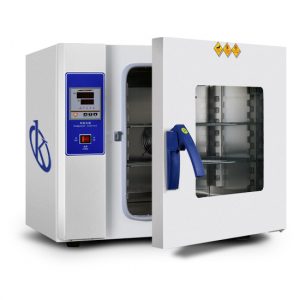Hot air is one of the most commonly used dry heat sterilization methods. This process is carried out in the ovens, which allow the uniform distribution of heat inside, where the material is exposed to temperatures of approximately 170ºC for 2 hours.
Dry heat sterilization causes the destruction of microorganisms by oxidation of their cellular components. This is a less efficient process than wet heat sterilization because microorganisms die more quickly when in the presence of water because it allows their protein configuration to be altered more easily and provides a means of evenly distributing heat throughout the sterilizing equipment’s internal chamber. For this reason, to achieve the sterilization of the material using dry heat, higher temperatures should be applied for a longer time.
The sterilization time must be determined for each type of material, for example in the case of highly heat-resistant materials, higher temperatures can be used for shorter times.
How do you sterilize using a ovens ?
To sterilize by means of hot air it is necessary to place the objects in a ovens. And bring the indoor air to a temperature between 150 and 190 degrees C. One of the first appliances used for this purpose was the Pasteur furnace, which was later replaced by hot air ovens. These consist of a double chamber, the hot air generated by an electrical resistance circulates through the main cavity and the space between both chambers, at variable temperatures, being the most recommended 170º C for the metal instruments and 140º C for the content of the drums. A stable temperature is maintained by metal thermostats called bimetallic pair, consisting of two metals of different coefficient of expansion. When one dilates, the other does not and arches. One end of this device is in contact with a switch that cuts off the power to the heating resistor.
What are the advantages of using dry sterilization?
Among the advantages of this method of sterilization are that it leaves no residue, and is a fast and economical method. It also allows the sterilization of materials not miscible with water such as powders, oils and fats. It is not corrosive to metals and instruments. Its main disadvantage is that it should only be used to sterilize thermostable materials and requires longer sterilization time, compared to moist heat, due to low heat penetration.
To control this sterilization process, physical indicators such as thermometers are used, which allow measuring the uniformity of the temperature of the internal chamber of the furnace, chemical indicators such as adhesive tapes and biological indicators such as Bacillus subtilis spores. This method is used for the sterilization of glass material, surgical instruments, metal needles, and water-immiscible materials. HERE
At Kalstein we are MANUFACTURERS and we offer you excellent laboratory ovens that will be very useful in the sterilization of medical and laboratory materials. Designed with the highest quality at the best PRICES in the market. That’s why we invite you to take a look HERE

